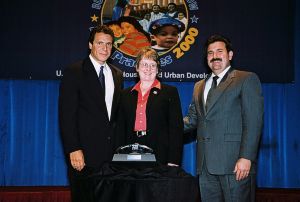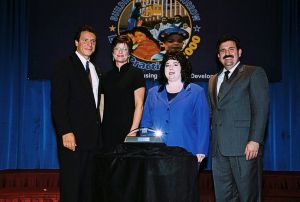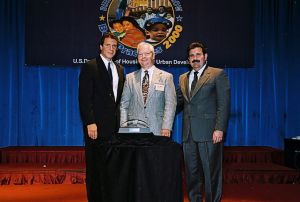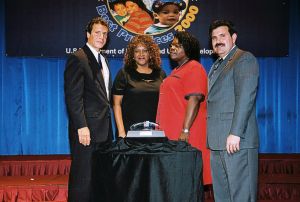 |
2000 Best Practice Awards
Best of the Best Winners: Texas
Best Practice: Job Creation Through Small
Business Development and Retention
TEXAS TOWN INVESTS IN ITS WORKFORCE THROUGH
A TECHNICAL COLLEGE AND BUSINESS INCUBATOR
Marshall, Texas. The community of Marshall is using a four-pronged educational
and employment approach to tackle the town’s long-term economic distress
from plant closings and production cutbacks in oilfield- and ammunition-related
industries. Although one-fourth of residents live in poverty, Marshall encouraged
development of 61 small businesses resulting in 195 jobs and opened a technical
college where 400 residents are currently enrolled.
To overcome limited educational and skill
levels and high levels of illiteracy, the city |

Janet Cook (c) receiving Best of the Best
award from Secretary Cuomo (l) and Deputy Secretary Ramirez (r) |
undertook four programs offering basic academic
skills and training in advanced technologies:
- A Marshall campus of the Texas State Technical
College to offer the technical training that pays high wages and is in
demand by employers
- Literacy education through partnership with
the local literacy council
- An aggressive small business development
and retention program to create jobs
- Funds to support small business development
Marshall’s first project was a city-owned
Business Development Center launched in 1990. Next, the community lobbied
the state legislature to create and fund the operational costs of the technical
college, which opened in 1993. In 1995, local banks formed a bank-sponsored
community development corporation that makes loan funds available to micro-businesses
in partnership with the Business Development Center. The center’s
staff provides loan applicants with the technical assistance needed to prepare
business plans and loan applications.
Using the college’s high-tech resources,
the Development Center expanded in 1999 to a business incubator called the
Center for Applied Technology, located on the campus. The close relationship
between the incubator and the college will provide opportunities for technology
transfer and ensure support from college faculty. One of the incubator’s
buildings serves as an inexpensive retail cooperative for local manufacturers
to sell their products, allowing them to increase revenue and jobs. A second
building operates as an arts incubator where eight resident artists have
opened retail studios and 11 artists participate in a cooperative teaching
program. The center provides space for instruction and shares course fees
with instructors.
The program involved partnership and funding
from local, state and federal government agencies, three nonprofits and
private businesses that donated land, buildings, equipment and expertise.
Marshall Economic and Development Corporation funds supported the Business
Development Center, campus land purchase and site construction. CDBG funds
helped supplement the operational costs of the literacy council. The U.S.
Department of Agriculture’s Rural Development Agency awarded funds
for a small business loan program. The U.S. Department of Commerce Economic
Development Administration funded the business incubator, high-technology
center and campus construction.
In an area seeking to renew its economic base,
partners needed little convincing to support long-term economic opportunity
by investing in a well-educated and well-trained workforce.
Contact: Janet Cook, Phone: (903) 935-4455
Tracking Number: 304
Winning Category: Geographic |
Best Practice: Texoma Housing Partners
NEW COLLABORATION SAVES NEAR-TROUBLED
HOUSING AUTHORITIES
Bonham, Texas. In rural north central Texas, you can drive 15 miles and
hit three public housing authority jurisdictions. Less than 10 years ago,
these small housing authorities struggled to survive and sustain the low-income
families they supported. To assist these near-troubled authorities, HUD
Fort Worth staff asked the Texas Council of Governments (TxCOG) to become
involved. In 1993, TxCOG established administrative contracts with eight
of the authorities to provide professional management from one office.
As word began to spread throughout the area
about the efficiency of TxCOG’s |

Allison Cardell and Susan Budrah receiving
Best of the Best award from Secretary Cuomo (l) and Deputy Secretary Ramirez
(r) |
management, other public housing authorities
joined the partnership, which became a nonprofit organization called Texoma
Housing Partners. To date, 16 authorities ranging in size from 6 to 104
units totaling approximately 500 units partici-pate in the partnership,
which covers four north-central Texas counties. Thus began the long process
of working with the separate housing authority boards to form one board,
one budget, one administrative staff and a centralized maintenance
crew, on call 24 hours a day.
The Texoma Housing Partners is the first organization
to implement the Quality Housing and Work Respon-sibility Act of 1998, which
allows two or more small housing authorities to develop partnerships to
operate their programs. Texoma Housing Partners have faced the challenges
that accompany unpaved paths. Housing authority board members with many
years invested in their city agendas initially questioned merging into one
board with one representative from each authority. TxCOG staff built trust
by meeting with the housing authority boards one at a time to discuss the
financial and administrative benefits.
Streamlined operations and dramatic cuts in
duplicated expenses eventually convinced the housing authorities to join
the partnership. Anticipated annual savings run between $75,000 and $100,000.
Specific savings are expected from limiting expenses such as conducting
one audit at a cost of approximately $1,000 rather than 16 audits, one set
of construction bids requiring advertisements costing approximately $1,000
rather than 16 bids and ads, insurance for one board at approximately $2,500
rather than insurance for 16 boards, and one in-house certified public accountant.
“Since a six-unit housing authority has
similar requirements to a 6,000-unit housing authority,” says TxCOG
Public Housing Director Allison Cardile, “we are realizing the efficiencies
of grouping them together.”
Ultimately, the 1,200 residents of the housing
authorities benefit through better service, additional funds for capital
improvements and property compliance with HUD requirements such as fair
housing and safety issues. Vacancy rates have decreased because of the capital
improvements and expanded marketing. HUD monitoring staff can now work with
one administrative staff, and the housing authorities enjoy efficient management
and pooled resources.
Contact: Frances Pelley, Phone: (800) 677-8264
Tracking Number: 552
Winning Category: Program (Public and Indian Housing) |
Best Practice: Lubbock Habitat for Humanity
- Increasing Affordable Housing through Vocational Education
BUILDING A BETTER FUTURE THROUGH VOCATIONAL
EDUCATION
Lubbock, Texas. A partnership between Habitat for Humanity in Lubbock, Texas,
the Lubbock Independent School District, and the Windham School District
of the Texas Department of Criminal Justice has provided six homes to families
who could not otherwise afford a home or are currently living in substandard
or shared housing. The partnership helps address the real need for affordable
housing for low- to very low-income families, the need for skilled construction
workers and the need for vocational education to provide marketable skills
for both students and prisoners.
The vocational education consists of |

John Mallory (c) receiving Best of the Best
award from Secretary Cuomo (l) and Deputy Secretary Ramirez (r) |
classroom time and hands-on experience. Lubbock
Habitat provides the funding for the materials and the licensed labor needed
to build a house. The students build the house in a parking lot, and after
completion of the students’ portion, the home is moved to its site
where Habitat volunteers complete the home. The first home built under this
partnership was dedicated in November 1998. Since that time, two more homes
have been completed.
The partnership with the Texas Department
of Criminal Justice was established in September 1998, and the first
home was constructed as part of two 90-day courses. The inmates built the
home, did the rough plumbing and wiring, as well as put in the insulation,
windows and doors. This program teaches inmates marketable skills that they
can use when they leave the correctional facility, and the inmates will
see tangible results of their labor.
Lubbock Habitat not only instituted a creative
way to provide labor for the construction of homes, but also provided
students and inmates with a program that gives them valuable trade skills.
Taxpayers benefit because the tax base has increased.
The Lubbock partnership can be replicated
in three easy steps:
- Determine a source of funds for materials
and paid labor. Grants or charitable contributions can be used. Although
Lubbock Habitat used no HUD funding, the program could easily be modified
to use HUD funds. Providing both housing and vocational education is a
good way to leverage funds.
- Determine a basic outline for the proposed
partnership, i.e., who will provide the materials and services.
- Seek and obtain a partnership with school
or correctional facility.
Contact: John Mallory, Phone: (806) 763-4663
Tracking Number: 872
Winning Category: Geographic |
Best Practice: The Village at Fox Creek
The Village at Fox Creek Provides New
Housing with Access to Amenities
Killeen, Texas. A housing development in Texas, the Village at Fox Creek,
provides low- and very low-income families access to new housing units located
near a main thoroughfare as well as life-enhancing amenities. This is the
first affordable housing development in the community of Killeen that combines
housing units near multiple services—employment opportunities, shopping
and medical services— specifically for the low- and very low-income
community.
Thirteen percent of the 128 new affordable
housing units provided by the program are designed to meet accessibility
requirements |

Cinda Hayward (c) receiving Best of the Best
award from Secretary Cuomo (l) and Deputy Secretary Ramirez (r) |
for individuals who have visual, physical
and mobility impairments.
The development was made possible through
the collaborative efforts of private sector funding, HOME Investment Partnerships
Program funding and the Low Income Housing Tax Credit Program. The project
makes it possible for the occupants to be able to access employment opportunities,
medical services, school and educational services, as well as being conveniently
located near shopping and recreational facilities.
To replicate this project, the first step
would be to perform a community needs assessment to determine the housing
need of low- and very-low income households, factoring in the population
and demographics of those who would occupy the units (general population,
elderly, etc.).
The second is to seek partnerships and support
from within the community as well as local, state, and federal government
leaders to approach and seek out reputable affordable housing developers.
It is important to determine project cost and time for completion—location
will be a key factor in placing the project in a highly accessible area
near necessities and amenities (employment, schools, medical access and
elementary, secondary and higher education sources). It is also helpful
to provide the public and beneficiaries with resources so they will become
involved in the excitement of the development. Addressing all technical
aspects of the development, ensuring an effective action plan for monitoring
and maintaining communications is imperative so that all parties involved
are aware of the expectations of the administrator.
Contact: Cinda Hayward, Phone: (254) 501-7841
Tracking Number: 852
Winning Category: Program (Community Planning and Development) |
Best Practice: Austin Works Together
"Austin Works Together" Project
Moves Welfare Recipients to Self-Sufficiency
Austin, Texas. The Housing Authority of the city of Austin, Texas developed
the Austin Works Together (AWT) project to help welfare recipients and other
eligible individuals make the transition from welfare dependence to self-sufficiency.
The combination of welfare reform, a disjointed, inefficient service delivery
system and local economic factors generated a need for a comprehensive,
intensive welfare-to-work program. A 1998 survey of public housing residents
revealed that 62 percent have no high school diploma or GED, and 27 percent
have an education level of ninth grade or below. |

Craig Harrick and Cindy Vartch receiving Best
of the Best award from Secretary Cuomo (l) and Deputy Secretary Ramirez
(r) |
To date, 67 project participants are employed, and the project is projected
to exceed its enrollment goals by up to 25 percent.
The Austin Works Together Project is an excellent
example of the capacity that housing authorities have to affect welfare
reform efforts in their communities. Historically, Austin’s service
delivery system for workforce development has been disjointed; although
government agencies and private nonprofit organizations served many of the
same people, they rarely collaborated in a substantive way.
The absence of collaboration acted as a barrier
to creative, effective approaches to welfare reform. For example, an agency
that helped someone obtain a job did not have the services to allow that
person to retain the job and earn higher wages. Austin Works Together
was designed to help break this pattern. Case managers assess client
interests, strengths and needs and tailor the services accordingly. The
housing authority helped break this pattern of isolation by agreeing to
administer $1.7 million in Department of Labor welfare-to-work grant funds.
“Austin Works Together brings many partners together and provide services
and programs for our residents right where they live,” says James Hargrove,
the housing authority’s executive director.
Case managers refer clients to AWT partners
for education, training and job placement services. The Central East Austin
Community Organization (CEACO) provides professional clothing for interviews
and recruits mentors, many of whom are former welfare recipients. CEACO’s
Job Success Workshop is a 30-hour course that teaches job search techniques
and important life skills such as budgeting, communication, assertiveness,
crisis coping and parenting.
“Austin Works Together provides multiple
training opportunities and job opportunities to traditionally underemployed
populations,” says Hargrove. “As a result of these efforts, many
families that would otherwise be unemployed have found jobs.”
In order to replicate this project or to simply
attract more workforce development resources for its residents, a housing
authority can:
l Demonstrate its commitment to welfare reform.
l Establish a reputation as a good partner. l Establish a relationship with
its local Workforce Board. l If given responsibility for administering a
sizable project, a housing authority should secure the resources to hire
a coordinator who will oversee the project. The coordinator manages the
procurement process and provides ongoing technical assistance and monitoring
of all project partners.
Contact: James Hargrove, Phone: (512) 477-4488
Tracking Number: 1174
Winning Category: Geographic |
Best Practice: Community Development Block Grant (CDBG) Sidewalk Job Training
Project
CDBG Sidewalk Job Training Project Provides
both Job Skills and Better Sidewalks
Wichita Falls, Texas. The City of Wichita Falls, Texas has developed a program
that fulfills two needs in the community: the Sidewalk Job Training
Project repairs public sidewalks and provides unemployed or unskilled
individuals the opportunity to acquire valuable job skills. This unique
program teaches participants the basics of concrete work through sidewalk
construction and allows them the opportunity to attain a commercial
driver’s license.
With long-term highway construction projects
underway, the City of Wichita Falls was facing a shortage of trained
labor and construction workers. In addition, sidewalks |

David Clark and Catherine Fitch receiving
Best of the Best award from Secretary Cuomo (l) and Deputy Secretary Ramirez
(r) |
in many areas of the city were aging and had
fallen into disrepair. The Sidewalk Job Training Project provides the maintenance
and repair services that improve the quality of life in neighborhoods, while
creating a skilled labor force capable of gaining full time employment.
The program is operated by the City of Wichita
Falls through Community Development Block Grant funds. It is a six-month
job training program for individuals with few or no job skills—often
participants who enter the program are dependent on welfare. The City provides
employees to supervise the project and provide training, in addition to
supplying needed equipment and wages for the participants. In return, workers
learn to operate equipment and tools, remove old concrete, build concrete
forms, and pour and smooth new concrete. The skills and work experience
increase participants’ marketability in the local labor market and
also exposes them to the intangible qualities that help them find and maintain
employment, such as the value of job responsibility and how to meet performance
standards.
By working in the Sidewalk Job Training Project, participants have the opportunity
and are encouraged to apply for a commercial driver’s license. Since
Texas law requires that applicants be employed in a position requiring a
commercial driver’s license before the test can be administered, participating
in the program provides a rare opportunity to receive this valuable certification.
The program also makes vehicles available to workers so they can take the
driving portion of the test.
The Sidewalk Job Training program takes advantage
of the rain delays that prevent cement work by creating additional learning
opportunities for participants. During this time they can learn more about
concrete forms, take safety courses, and tour local concrete plans and laboratories
to learn about the technical properties of concrete. Workers can also
use this time to study for their driver’s license exam.
A significant benefit of the program for participants
is the experience with city projects and the solid job attendance track
record they can achieve, which helps in applying for permanent city jobs.
Of the 48 individuals who have participated in the program, 18 have been
promoted to full-time employment with the City of Wichita Falls and
16 have been hired by other employers or have gone on to attend college.
The benefits of the Sidewalk Job Training
project also extend to the livability of the City, since improving sidewalks
can have a great impact on the appearance and the safety of a neighborhood.
The program focuses on repairing dilapidated sidewalks or creating sidewalks
in CDBG target areas, providing improvements in sectors of the community
such as low-income neighborhoods, the downtown area, city parks, areas around
public schools, and public facilities in the city and the county. The program
also builds wheelchair-accessible ramps when needed.
Contact: Catherine Fitch, Phone: (940) 761-7454
Tracking Number: 2539
Winning Category: Geographic |
Best Practice: Central Dallas Ministries-Church
Health Ministries
Central Dallas Ministries Lend A Hand to
the Community
Dallas, Texas. The Church Health Ministries
is a collaborative effort responding to the need for improved preventative
health care treatment for low-income and uninsured residents of East Dallas.
By working with health care institutions and area churches, the services
of the Central Dallas Ministries walk-in medical clinic have been expanded
to include preventative care that reduces the number of emergency room visits
by area residents.
Central Dallas Ministries has been serving
residents in Dallas Housing Authority communities and surrounding neighborhoods
for more than 10 years, providing services ranging from food pantries to
GED training, |

Marcia Epperson and Marcia Lewis receiving
Best of the Best award from Secretary Cuomo (l) and Deputy Secretary Ramirez
(r) |
to summer camp for kids, as well as conducting
a weekly walk-in medical and dental clinic. As the number of emergency room
and hospital admissions for residents of this area began to rise, a major
gap in the affordable health care services available to the neighborhoods
served by Central Dallas Ministries was identified. A collaboration of area
health care systems, including Baylor University and the County hospital;
the East Dallas Weed and Seed program to prevent drug use; several local
churches and community providers; and the Central Dallas Ministries came
together to address the issues.
In 1998, the work of the partnership led to
the creation of the Church Health Ministries program. Through Church Health
Ministries, the services of the medical and dental clinic operated by Central
Dallas Ministries were greatly expanded to incorporate preventative care,
including physicals, well-women exams, cancer screenings, and other health
services. These medical services are available to residents who are unemployed
or, more often employed but unable to afford health insurance.
Church Health Ministries also launched strategic outreach efforts to overcome
the fear and mistrust some residents had of the health care system by utilizing
organizations they trust: their churches. To emphasize the need for regular
medical exams and raise awareness of the programs available, Church Health
Ministries works with members of local congregations to provide three levels
of health assistance. Congregational Nurses are registered nurses who act
as health counselors and educators, and provide referrals to their congregations.
Lay Health Promoters also act within the congregations as extensions of
the nurses, referring individuals for further evaluation and sometimes accompanying
patients to their medical appointments. Benefits Counselors work with patients
and community members to explain the processes and evaluate their eligibility
for accessing various health benefit programs. Many patients are unaware
that they are eligible for programs such as Medicaid or the Children’s
Health Insurance Program (CHIP).
By working closely with the neighborhoods
it serves and listening to resident’s concerns, Church Health Ministries
develops the care that people need and also brings in people who might not
otherwise be involved in its programs. In 1999, the 900 volunteers of the
program made more than 7,500 patient contacts in the community through the
clinics, referrals, or benefits guidance. Preliminary findings also show
that the areas targeted by the program have experienced a drop in hospital
emergency room visits.
Contact: Larry James, Phone: (214) 823-8710 Ext.17
Tracking Number: 912
Winning Category: Program (Public and Indian Housing) |
Return to Best
Practices 2000 Best of the Best Winners
Content Archived: April 20, 2011 |